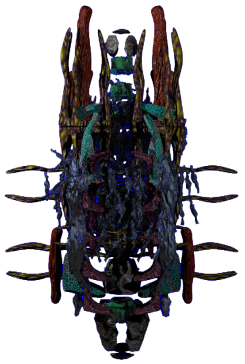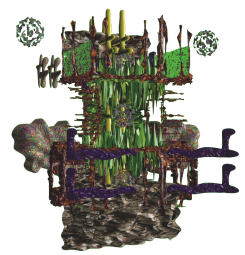Systems ecology is an interdisciplinary field of ecology that is distinguished by its holistic approach to the study of ecosystems. It focuses on the complex and emergent properties of ecosystems, examining the networks of human and non-human agents that influence them. sete’s Dark Precursor Project aims at a comprehensive study of the ecosystem of exoplanet Perl 26b. Presented here are three species of the turian class that inhabit many of Perl 26b’s oceans. The project aims to reveal the discovery of new turian species on Perl 26b to the public.
Cipher serpentina
 Cipher serpentina is a member of the family Cipheron that is comprised of 28 genera and contains over 88 species. Current population estimates range from 150,000 to 180,000. Typical weight ranges from 30 to 45 tonnes. They have been observed at depths of up to 900 metres. They occupy most of the Pacific, but are particularly prominent within its central and western regions. Like most members of the Cipheron family, Cipher serpentina employ electromagnetic pulses released from their skin to both navigate and communicate. They are a social species, and typically travel in groups of 50 to 200. They are carnivores and their diet mostly consists of small Lapacians.
Cipher serpentina is a member of the family Cipheron that is comprised of 28 genera and contains over 88 species. Current population estimates range from 150,000 to 180,000. Typical weight ranges from 30 to 45 tonnes. They have been observed at depths of up to 900 metres. They occupy most of the Pacific, but are particularly prominent within its central and western regions. Like most members of the Cipheron family, Cipher serpentina employ electromagnetic pulses released from their skin to both navigate and communicate. They are a social species, and typically travel in groups of 50 to 200. They are carnivores and their diet mostly consists of small Lapacians.
Cipher terribilis
 Cipher terribilis is another member of the family Cipheron. Current population estimates range from 2,800,000 to 3,000,000. Typical weight ranges from 10 to 15 tonnes. They have been observed at depths of up to 1,200 metres and can be found throughout the Pacific. The spikes covering their body provide a strong defense against predators. For movement, Cipher terribilis employ a number of fins on both the front and back of their bodies. As a group species, they typically travel in groups of 180 to 300. Like Cipher serpentina, Cipher terribilis are carnivores and their diet mostly consists of small Lapacians.
Cipher terribilis is another member of the family Cipheron. Current population estimates range from 2,800,000 to 3,000,000. Typical weight ranges from 10 to 15 tonnes. They have been observed at depths of up to 1,200 metres and can be found throughout the Pacific. The spikes covering their body provide a strong defense against predators. For movement, Cipher terribilis employ a number of fins on both the front and back of their bodies. As a group species, they typically travel in groups of 180 to 300. Like Cipher serpentina, Cipher terribilis are carnivores and their diet mostly consists of small Lapacians.
Galeocerdo akallopisos
 Galeocerdo akallopisos is the solitary member of the family Galeocerdo. Current population estimates range from 300,000 to 320,000. Their typical weight is 2,260 kilograms. They dwell above the depth 300 metres. Their populations are concentrated around the southern hemisphere and they are attracted to coastal areas. Their skin is coloured and textured to blend in with their habitat, making them nearly invisible to prey. The eyes of Galeocerdo akallopisos are positioned very high on their heads, helping them locate prey swimming on the surface. Galeocerdo akallopisos are solitary animals. Interaction with other members of their species is largely restricted to mating and birth.
Galeocerdo akallopisos is the solitary member of the family Galeocerdo. Current population estimates range from 300,000 to 320,000. Their typical weight is 2,260 kilograms. They dwell above the depth 300 metres. Their populations are concentrated around the southern hemisphere and they are attracted to coastal areas. Their skin is coloured and textured to blend in with their habitat, making them nearly invisible to prey. The eyes of Galeocerdo akallopisos are positioned very high on their heads, helping them locate prey swimming on the surface. Galeocerdo akallopisos are solitary animals. Interaction with other members of their species is largely restricted to mating and birth.

